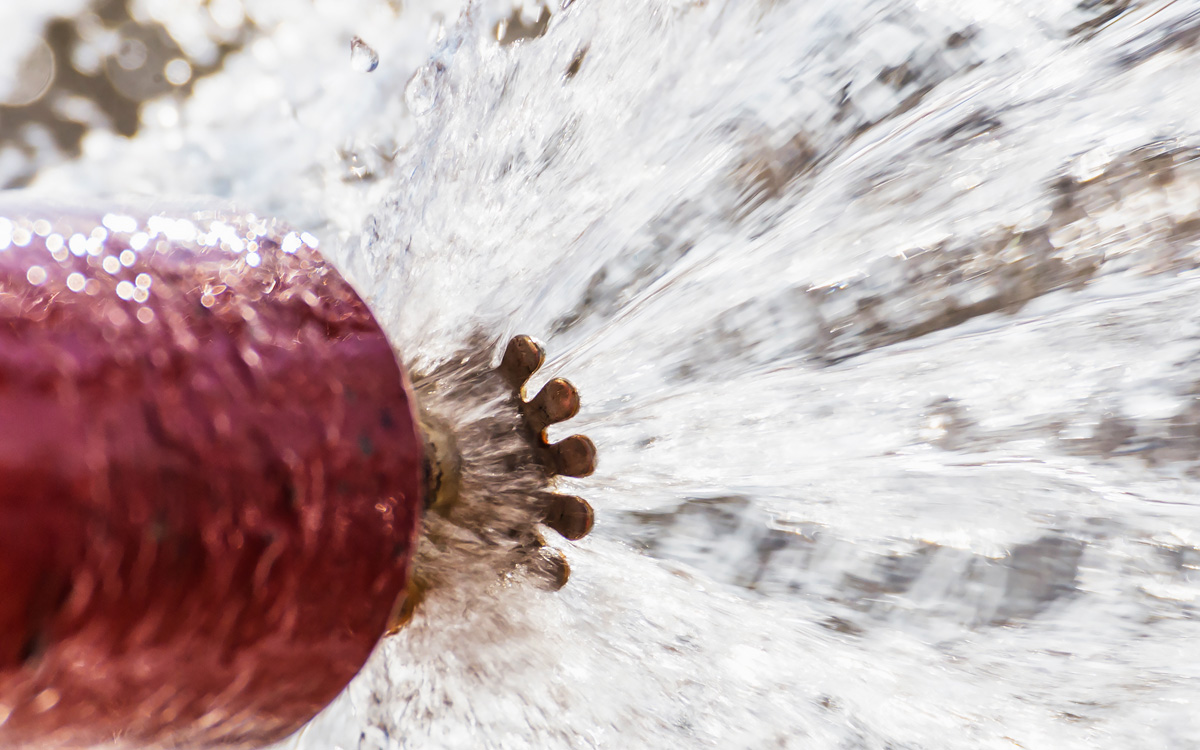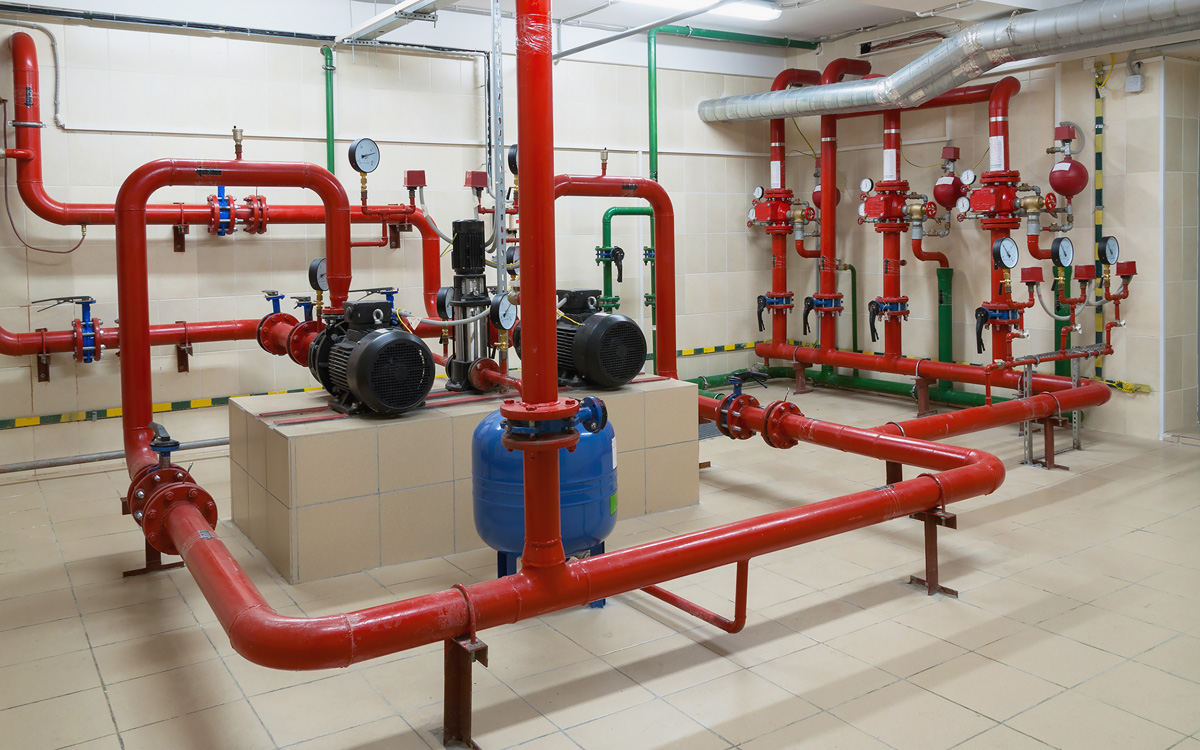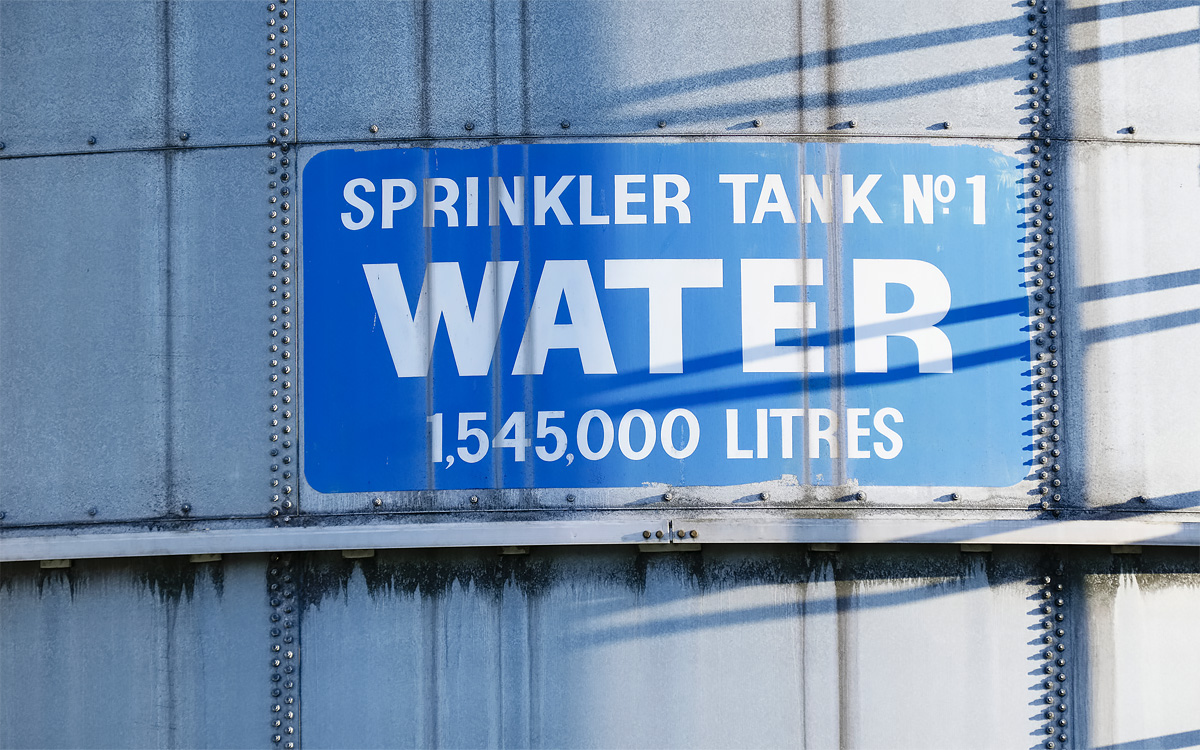The function of the automatic fire extinguishing system is to detect a fire inside or outside the building, send an alarm to the rescue authorities and control the fire by spraying the fire area with extinguishing agent. The systems aim to extinguish the fire or at least limit its spread until the rescue service come to put out the fire.
The extinguishing system is selected based on, among other things, the space to be protected, the extent of protection, the property to be protected and the requirements set by personal safety. Water, gases or foam are used as extinguishing agents. Water is the oldest and by far the most used fire extinguisher agent. It is indeed an excellent substance for suppress a fire: in addition to binding heat effectively, it’s cheap, non-toxic, easily available and harmless to the environment.
The effectiveness of water as a fire extinguisher is based on its ability to bind large amounts of heat when it evaporates. Water keeps the fire under control by taking the energy needed for evaporation from it. Evaporation of water forms water vapor which as an inert gas dilutes the oxygen content of the burning space by displacing oxygen near the fire. When water evaporates, its volume increases up to 1700 times, so the steam flowing out from a burning space also prevents the flow of oxygen needed for combustion to the fire. The decrease in oxygen concentration slows down the burning rate and may even suppress the fire completely.
The use of gases as an extinguishing agent is based on breaking the chain reactions of combustion and displacing oxygen from the burning space. However, the cooling power of water is superior to gases. In foam fire suppression systems, a foam concentrate is mixed with the extinguishing water and air. Foaming agent enhances extinguishing.
When choosing an extinguisher agent, both the properties of the burning materials and personal safety must be taken into account. Foaming agent is, for example, an effective way to extinguish spaces containing flammable liquids, as it forms a fire-insulating film on the surface of the liquid and reduces the splashing of flammable liquids caused by the kinetic energy of large water droplets. Gas, on the other hand, extinguishes very quickly without water damage and laborious clean-up, so it is used for example in data centers and museums that would be seriously damaged by water. On the other hand, the use of carbon dioxide (which displaces oxygen) as a extinguishing agent is life-threatening for people.
Sprinkler systems
The traditional sprinkler system is the most commonly used automatic fire extinguishing system. It is a surprisingly old invention, as few would guess that sprinklers have been protecting Finnish buildings for 130 years. Finland’s first automatic fire extinguishing system was introduced in Tampere at the Finlayson factories in 1892.
A typical sprinkler system consists of a water supply, a valve between the sprinkler piping and the water supply, sprinkler piping, and sprinkler heads that spray pressurized water onto the fire. The design and implementation of the system is influenced by, among other things, the size of the space to be protected, the purpose of use and the estimated fire load. The automatic operation is based on a heat-responsive element that prevents the flow of water or gas in the pipeline from the sprinkler head. The element is usually a sealed liquid-filled glass bulb filled with a colored glycerin-based liquid, or a metal fuse. When the temperature of the space surrounding the sprinkler head exceeds the trigger temperature, the sprinkler is triggered and allows water to flow through the sprinkler head into the burning space. The deflector plate in front of the sprinkler head gives the water spray its shape.
The water supply can be a public water main, separate water tank with pump systems or a natural water source, such as a river or lake. A public water main is sufficient if the required amount of water can be extracted from it with sufficient pressure. In a smaller locations a public water main is usually sufficient. If the flow and pressure produced by the public water main are not sufficient, a sprinkler tank is installed in the system, from which the water is fed into the pipeline with the help of sprinkler pumps. If the flow is sufficient but the pressure is not, sprinkler booster pumps are installed in the system to increase the pressure.
Implementation options for the sprinkler system
There are different options for implementing a sprinkler system depending on the space to be protected or the purpose of use. The most common indoors is a wet pipe system, where the sprinkler piping is constantly full of water under pressure. Wet pipe system works quickly, but the installation is not suitable for locations where the water is at risk of freezing or boiling. The most common installation method for outdoor spaces is dry pipe system, where the pipeline is filled with compressed air or inert gas that flows out ahead of the extinguishing water. In small outdoor installations, a mixture of water and antifreeze can also be used.
Sprinklers can be triggered individually, per area or as a pre-trigger. In a normal situation, individual sprinkler heads close to the fire are triggered. If the fire progresses, the new heads will only be triggered when the fire approaches them. In area-specific triggering, all sprinklers in the specified area are triggered at once. In pre-triggering, the sprinklers are triggered by a separate fire alarm system. Pre-triggering is used in situations where fire suppression must start as quickly as possible.
Water mist fire protection systems
In addition to traditional sprinkler systems, extinguishing systems based on water mist are used today. The structure of the water mist system is basically similar to that of the sprinkler system, including the water supply, piping and nozzles, but unlike the sprinkler system, the operation is based on the production of very small water droplets with high pressure. The water mist system is installed like sprinkler systems either – as a wet pipe system or a dry pipe system. The system can be designed as a low-pressure, medium-pressure or high-pressure type. The higher the pressure used in the system, the smaller droplets the water flowing through the nozzle breaks up into. In this article, we will mainly discuss about high-pressure water mist systems.
The water mist cuts off the thermal radiation
The fire suppression mechanisms work more efficiently the more surface area the water spreading into the burning space has. The small droplets of water mist evaporate and vaporize quickly because they have a large surface area in relation to their volume.
The droplet size produced by a traditional sprinkler is of the order of a raindrop. One drop has a diameter of about a millimeter. The droplet size produced by the high-pressure water mist system, on the other hand, is very small, even less than 80 µm, so the free surface area of the water mist is significantly larger than with a sprinkler spray. If with a traditional sprinkler a liter of water produces a vaporizing surface area of about 6 m2, with a high-pressure water mist the free surface area may be 50–60 m2. Thus, the cooling power of the high-pressure water mist is many times higher than that of the water spray from the sprinklers, and it extinguishes effectively with a small amount of water.
Less water damage with water mist
Traditional low-pressure sprinkler systems release a large amount of water during a fire, which can cause significant damage to the protected space and its equipment. A large amount of water can also damage objects due to its cooling effect, for example by cooling hot machines or pumps too quickly. Due to the wide nozzle coverage, the water mist system has fewer sprinkler heads that trigger and much less water is used, so water damage remains smaller. The mist also evaporates quickly and ponding slowly. Therefore, water mist systems are often used in locations where the amount of water sprayed by a traditional sprinkler system would cause serious damage to property. In smaller sites, the amount of water even for a traditional sprinkler is still mostly moderate, in industrial sites, more water is used.
In addition to cooling, the small water droplets of the water mist effectively dampen heat radiation by scattering and absorbing it. It is said that water mist cuts off thermal radiation. When the combustible space is filled with water mist, its temperature drops quickly and remains very low (50–60 °C), which prevents the ignition of non-combustible surfaces and slows down the burning of combustible surfaces. Thanks to the attenuation of thermal radiation, water mist can effectively limit even large fires.
More opportunities for creative solutions
High-pressure water mist excels in versatile and challenging sites, such as high-construction sites and wooden buildings. Water mist systems are excellently suited for large and uniform flexible spaces. The low temperature of the combustible space protected by water mist enables the safe growth of fire compartments and the use of unclassified structures as compartmentalizing structures. For example, fire doors and fire glass structures can be replaced with ordinary doors and lighter glass structures. Even the automatically functioning partitioning doors of long corridors can be replaced with water curtains, and at the same time eliminate the risk of failure and damage of fire doors.
The water mist system also enables a significant increase in the use of visible wood surfaces in cladding. The wooden surface can even be used as a surface material for exit routes. The “two-meter corner rule” does not have to be applied either. In many locations, the same results can also be achieved with so-called “border spraying”, but it uses more water and may cause more extensive damage.
Choosing the right fire extinguishing system
Drawing the line between traditional sprinklers and water mist systems is becoming increasingly difficult these days. That’s why it’s worth comparing and examining the systems on a site-by-site basis already in the project planning phase.
High-pressure water mist
I many cases high-pressure water mist system is more efficient than traditional sprinkler system. By choosing water mist system significant savings can be achieved in both structural and fire and building technology solutions through the performance-based fire safety design. More savings are obtained during the use of the building through lower operating costs. A water mist system takes up less space than a large sprinkler center and weighs significantly less than a traditional sprinkler system, which may be of great importance in some cases. The smaller pipe size of the high-pressure mist system is important, especially in installations in tight spaces.
Water mist does not conduct electricity and does not damage sensitive equipment, so the same extinguishing system can protect all rooms, including electrical and electronic equipment rooms and computer rooms. A separate, expensive gas extinguishing system can therefore be forgotten and at the same time avoid changing the bottles of the gas extinguishing system. The water mist system can also be used to fight liquid fires.
However, water mist system is not suitable for all uses. If the required sprinkler class is high or the premises are tall, the choice of a high-pressure water mist system is often not justified.
Traditional sprinkler system
Traditional sprinklers have their own applications where it is difficult to replace them with water mist system. The sprinklers are perfectly suited for small (up to 5000 m2) and conventional sites that do not have special structures, such as partitioning glass structures or fire protection of steel structures. In addition, sprinklers are the right choice for many industrial sites, such as large warehouse buildings, which require such high fire hazard classes that the classifications of current water mist systems are not sufficient. This is not so much a question of the shortcomings of the technology, but of the market potential of these objects, which is comparatively small. Therefore, the manufacturers of water mist systems have not considered it reasonable to conduct the expensive combustion tests required to obtain the ratings.
Sprinkler systems have traditionally been more affordable than water mist systems, but the price of water mist systems has also decreased in recent years, and the reputation of an expensive system is no longer necessarily justified in all cases.
The differences between a sprinkler system and a water mist system
Traditional sprinkler system
High-pressure water mist
Traditional sprinkler system
- traditional and commonly used system
- extinguishing a fire by cooling with water
- requires large pipes (25-110 mm)
- installation can be challenging in tight spaces
- if the water output of the normal public water main is not sufficient, a water tank (5-50 m³, up to hundreds of cubic meters) may be needed
- large sprinkler centers take up space
- limiting the heat rise is not very effective
- large ‘raindrop size’
- may cause major water damage; the water evaporates slowly and ponding quickly
- aesthetically often quite rough-looking.
High-pressure water mist
- extinguishing fire by cooling through vaporization, works in three dimensions
- small-sized pipes (12-54 mm), small space requirements, suitable for tight spaces
- nozzle coverage up to 50 m², fewer nozzles
- usually the yield of a public water main connection is sufficient without other solutions, 40-50 m³ is also sufficient for a class A water source
- powerful heat-absorbing capability cuts off heat radiation
- even flow per nozzle regardless of the number of triggered nozzles up to the dimensioning area
- very small droplet size (< 80 µm)
- limited water damage; the water mist evaporates quickly and ponding slowly
- aesthetically clean and nice, pipe and connector materials options in stainless steel
- the nozzles are flush-mountable and structurally well protected from damage
- short installation time, flexible to build, space saving
- suitable for flexible spaces, maximum benefit in open and large fire departments
- because water mist does not conduct electricity, it can protect almost every room
- remote operation and maintenance
- long-lasting and almost maintenance-free.
The share of the water supply in the costs of the fire extinguishing system varies greatly from site to site. A traditional sprinkler often works at the pressure level and flow of the public water main. Expensive sprinkler booster pumps or separate water tanks are usually not needed. In some large sprinkler sites, several sprinkler stations and booster pumps may be needed, which increase costs and also take up a lot of space. If a separate water supply has to be built for the sprinkler system and it also has to be placed, for example, in a space where the rock is excavated separately for it, the costs increase sharply.
The amount of water needed by the high-pressure water mist can usually be taken from a conventional public water main. On the other hand, the high-pressure fog system always requires an electrical connection to operate. In some locations, this can become expensive due to connection fees and the installation of new cables.
In terms of pipelines, stainless steel pipes will be more expensive than traditional sprinkler pipelines. On the other hand, the nozzle coverage of the water mist system is higher compared to the sprinkler system, so fewer nozzles are needed.
Life cycle costs
Remote maintenance of water mist systems and real-time condition monitoring increase the operational reliability of the system. The water mist systems is said to be long-lasting and maintenance-free. However, mist systems are not completely maintenance-free – maintenance requiring special expertise is required every year. The traditional sprinkler system, on the other hand, can be maintained by any approved sprinkler system company.
In a sprinkler system, the water charges, measurement and settlement work, as well as testing and other costs significantly increase the costs during the life cycle of use.
The costs of modification and expansion
Expanding the sprinkler system and increasing its capacity may be expensive. The expansion of the high-pressure water mist system can be implemented with the existing pump unit. On the other hand, the advantage of a traditional sprinkler in modification and expansion works is that these systems can be modified and expanded by any approved sprinkler system company. The availability of sprinkler system components, such as nozzles, installation valves and pipelines, is good and their price is more affordable compared to high-pressure water mist system components.
READ MORE
Read about our related services:






